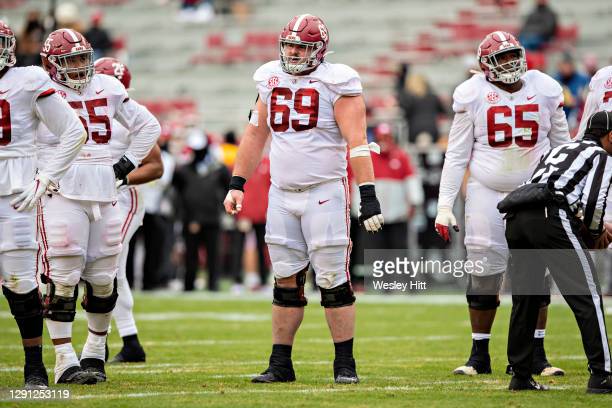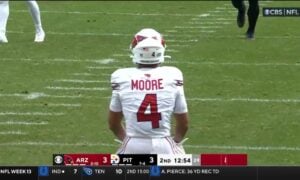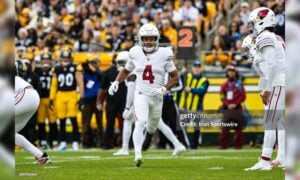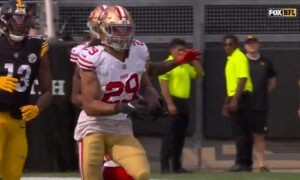The Steelers Big Board shares some basic flaws with every other you’ll find across the Internet. I fondly believe that we do a better job than most because of our focus on a single team. That lets us take things like team philosophy, scheme, and existing rosters into account, which no all-teams board can do. But there is no getting around the fact that we face some barriers the professionals can go past. We can’t do more than acknowledge those shortcomings directly. Here’s my list of the Hot Half Dozen:
- No ability to interview the prospects, which is essential to learning about their football IQ, approach to and love for the game, maturity, study habits, daily routines, expectations, etc.
- No access to college coaches and campuses for background on those same above-the-neck and in-the-heart issues over a long period and on a day to day basis, or about specific assignments on key plays in the film.
- No access to medical records or examinations, both from doctors and from conditioning experts/coaches that study how people move.
- No professional coaches with the experience to judge how hard it will be for a prospect to improve his game through specific changes or improvements in technique.
- Limited film to watch, which is often limited further by being TV coverage rather than all-22 coaching views.
- Limited expertise compared to professional scouts, and especially professionals who have colleagues to bounce things around with. This is balanced by the advantage of looking at the same player through dozens of different Internet and media eyes.
We cannot get around those problems; we can only accept them, and remind all the new people how big the margin of error really is. But every year there presents a smaller group of prospects who end up being particularly hard to grade, with a margin of error so big, or so inexplicable, that it makes the final ranking seem a little silly. Here are a few of the most notable ones from this year’s class.
Offensive Tackle Jaylen Mayfield, Michigan
The main hurdle here is youth. Mayfield is just approaching 20 years old(!), which means he hasn’t come close to maturing physically, mentally, spiritually, or technically. Let’s be clear about what that means. His body is still changing, so we do not know where his strength and balance are going to end up, and we outsiders cannot judge the work ethic needed to get there. His technique is unrefined, so we have to project how far he can go and how hard it will be to do it. We need to assume that he has the normal share of young-and-stupid that still needs to be shed, which means that interviews are key, and the environment he gets drafted into will alter his life path forever. All those question marks revolve around the “upstairs” stuff that we cannot access. And that yields an evaluation that can range anywhere from Top 15 based on potential, down to Round 3 based on the existing flaws.
That margin of error just expanded too, because he had a notably poor pro day. Mayfield’s ace in the hole has been tremendous native athleticism, but the pro day revealed a litany of challenges to attack that assumption. Short arms (32⅝”), smaller hands (9¾”), average mobility scores, and outright poor results in explosion numbers like the dash (5.31) and vertical jump (28½”). It adds up to a pretty bleak picture. He also looked and moved like a monster-sized boy rather than a would-be NFL man, which is why Daniel Jeremiah projects him as no more than a RT/G prospect at the end of that clip. OTOH, those numbers are way below expectations in every single category. This suggests some general problem, like a case of the flu… but the bottom line is that we now have an extra question mark to deal with.
Oh, and Jalen? Baby fat and a beardless face is not a good look for grownups who want to be your fans.
Offensive Tackle Walker Little, Stanford
Here’s an even harder problem: what do you do when the prospect hasn’t played a down in two whole years? Walker Little looked like a potential 1st-rounder in 2018, with fabulous physical assets and a solid grounding of basic technique. Perfect ground on which to build, and good OL coaching in a top notch program to help him do it. Enter 2019, when he blew out a knee in the opening game. Followed by no football at all in 2020 due to Covid.
What has he built on that nice, solid ground? How has he matured as a player and a man? Where is he at physically after two years of rehabbing, growing, maturing, and training? How has his game changed? How much could he possibly learn without regular practices, particularly with the kind of absorbing academic load that Stanford provides to even its student athletes? The teams will have a pretty good idea of where to grade Walker Little, but you and I haven’t got a prayer.
Offensive Tackle Josh Ball, Marshall by way of Florida State
The issue here comes down to off-field smoke. Ball was an all-star prospect at Florida State who got accused of domestic violence by a former girlfriend. The police investigated and filed no charges, but the case became a campus sensation and a school panel issued a suspension. In the end he fled from FSU to Marshall, where he had no reported problems, and where he continued to shine between the hashes – against a much lower level of competition.
So, you tell me: is he a potential danger to the community and undraftable? Is he a changed man who lost control but has since learned his lesson? Is it all a big nothing burger that blew up as some kind of symbol? Or is it some mix of those three, or something else completely? The pros have a chance to dig down toward the truth. The rest of us can only guess, and our opinions on the topic would say more about the speaker than the prospect.
And then there are those LOC questions… [Sigh]
Offensive Guard Trey Smith, Tennessee
This young man’s life is the stuff of a made for TV movie. Start with a 5-star athlete whose mother died young of heart problems that might be traceable to Smith’s own, life threatening blood clot problem in 2018. That scare forced him to miss 2018 in every conceivable way, since he wasn’t doing any workouts or drills while dealing with the medical emergency.
Now factor in the sort of intellect that earns all-academic awards even during these trying times, and the basic character to win the Jason Witten Collegiate Man of the Year award (CFB’s equivalent to the Walter Payton award). Then account for the toughness and grit that comes from overcoming his mother’s death, and his health crisis, and the threat to his future. And finally put on the cherry, that this young man’s solution to all of that came in the form of perseverance, hard work, and loyalty to himself and to those around him.
Got a daughter? This is someone you want her to date.
Next step: Mount the against-the-odds comeback against the blood clot problem. Make it vanish as mysteriously as it appeared. Watch him return to work. Watch him forgo the draft because his teammates needed him. Remind yourself that this is a 5-star athlete with unbelievable physical assets of size, strength, and basic athleticism. And then produce some meh film in 2019 and 2020, which would be good film for anyone else but disappoints compared to the native talent and expectations.
What the heck can you say?
Center/Guard Landon Dickerson, Alabama by way of Florida State
The tape says, “Round 1 every day and all day; pick him at 1:24 if he falls that far.” And it says even more, because he fits our particular team like he was made for the purpose. Daniel Jeremiah has described by Dickerson as “an almost perfect Steeler.” Nor is he the only one. Read through this tremendous, gif-supported scouting report from early February written by a well-respected coach and Steeler fan, which also makes the case for Dickerson at 1:24. See Lance Zierlein’s NFL.com scouting profile if you still have any doubts.
Hand? Meet glove.
But then you get to the terrifying medical red flags, which flash, “Do not touch with a 10 foot pole!” Dickerson played five (5) seasons in college. He finished in only one (1), as a RS Junior in 2019. His RS Senior and true Freshman years (2020 and 2016) ended with torn ACL’s, and his RS Freshman and RS Sophomore years (2018 and 2017) ended with ankle surgeries. Yikes. So: is it a trend that will continue, or was he just snakebit 80% of the time?
But what about the rest of the package? Centers have to be leaders, after all. Yes, they do. So consider this: After surgery the week before, Alabama dressed him anyway for the BCS championship coin toss, and then lined him up for the final kneel-down snap. Think about that. Nick Bloody Saban sacrificed a roster spot to dress someone who couldn’t play, just because that particular young man meant so much to his team and his coaches.
He’s either a Round 1 pick or a Day 3 flier, and all the in-between average grades are wrong. But what else can we do except average things out to say Round 2?
Center/Guard Trey Hill, Georgia
If you play the mock draft games you’ve probably noticed that Trey Hill’s stock varies all over the place. It comes down to medical questions. Hill played extremely well in 2019 as an enormous Center-capable Guard with great power, great leverage, and limited mobility. In 2020 he moved to Center full time but his film steadily declined. He kept playing ever more upright, with ever less mobility. It wasn’t a good look. Until he finally stopped playing completely, and the world learned that he’d been playing through agony for the sake of his team. Both knees required meniscus surgery.
So… would the real Trey Hill please stand up? Is he a Center-capable Guard? A Guard-capable Center? And are the knees an explanation, a medical red flag, or both?
WR Rondale Moore, Purdue
First comes the stereotype. Rondale Moore is a walking highlight reel who flashes around the football field like he was connected to a joystick; movement skills that were confirmed by testing such as a 4.27 dash and a 42½” vertical leap. He’s also chirpy on the field, and witty off it, as shown by his tagline: “How big is a football player?” Of course, that question comes up because he weighs 180 lbs., soaking wet, and stands at 5’7”. We’ve seen that stereotype before, haven’t we? We know how it’s going to play out, right?
Hold the phone. Here’s the part you don’t expect: 600 lb. squats, on film. Tiny person; el grande, mongo, first order freak. Which adds up to… what?
EDGE Jaelan Phillips, Florida by way of UCLA
Another case of medical red flags that are impossible for outsiders to judge. Phillips was a 5-star prospect at UCLA who got into a nasty car crash. Nasty as in multiple surgeries on his wrist, one after another after another. He then got a series of nasty concussions on and off the field. At which point he quit football completely, which I’m sure we can all understand.
But… he loved the darned game too much to leave it. So he transferred to Miami and has now matured into a physical specimen with the most sophisticated set of pass rush moves in the entire class. He’d be the clear Edge #1 of the year if not for all those lingering red flags. Gil Brandt has him at #11 overall… with a note that “he just needs to stay healthy.”
Is there a doctor in the house with access to both his medical records and a hands-on examination? Yes for the teams. For us… not exactly.
ILB Zaven Collins, Tulsa
This is a mystery case of physical descriptions that all sound like a player who ought to go in the middle of Round 1, offset by grades that never seem to rise beyond the very end of that round; and yet never fall beyond the early 2nd. How can there be such unanimity about the final, fringe-1st grade, and also unanimous opinions about the early-1st descriptions? The range isn’t that big, but the dissonance couldn’t be louder.
For those who don’t know, the comparisons we’re talking about are miracle athletes like Anthony Barr, Leighton Vander-Esch, and a young Brian Urlacher. This is a 6’4”, 260 lb. specimen who covers like a darned good Safety, but still packs enough of a wallop to win both of the high prestige honors for best CFB defensive player of the year (the Nagurski and the Bednarik awards). Many reviewers agree that he’s still a bit raw and will need good coaching to raise his football IQ to a full NFL standard. Others have pointed to a motor that occasionally dips down from red-hot to lukewarm. But you know what? I’ve done these boards for a lot of years, and those flaws do not explain how someone with these physical gifts can get a grade outside of the teens.
Something else is going on. I have no clue what it might be, except for a single (as in only one) Internet rumor (as in totally unconfirmed and from an amateur, potentially biased source) that he might have an unpleasant personality – on the campus in general, not from his teammates point of view. Lots of salt required for that one! But what else can explain it?
NOTE: This wonderful interview just appeared at TDN on Monday. I encourage both the Collins doubters and the Collins fans to give it a read.
ILB Baron Browning, Ohio State
Here’s a grade I expect to settle, but not without some fairly violent Twitter fights. Baron Browning entered college as a Safety, but then converted to ILB. The conversion took him some time because of the learning curve, and also because Ohio State had a bevy of talent. Then he kept on growing, until he now looks like a prototype Buck ILB, but still plays like a smaller man. The traits and the skill set do not match up, and the production lags behind. Far, far behind.
Browning presents such a puzzle for outsiders like us because we have to go with either (a) the established skills, which are those of a supersized Mack ILB that needs to work on his football IQ, or (b) the numbers, which label him as an ideal, super-athletic Buck ILB who hasn’t quite learned how to thump.
I think we will get closer, but the reality will always come down to “upstairs” questions we cannot follow to their root. Does he want to be a goon, or not?
ILB Dylan Moses, Alabama
This article grew out of my efforts to revise the Big Board description on Moses into something that would be a little more clear. This is where I’m at:
| Here’s the lead on basically every scouting report you’ll see: “Dylan Moses is a freak athlete.” He has every talent you look for: size, speed, fluidity, etc. The physical potential is all but unlimited, and it’s been that way since he made the cover of ESPN’s magazine in 8th grade for scholarship he’d received from both LSU and Alabama. The issues come down to the flip side of that coin. What does that do to to a 13 year old? Especially one with a father who raised him for the gridiron like some colossal stage mom? Those question marks – and they are only that, questions – pervade the discussion. Does he love the game enough for itself? Will he go sideways when he becomes his own man? Etc.
Everyone seems to have an internal plot line even though no outsider can really know, and thus interviews are going to drive his stock more than film. It gets worse because he looked like a potential Top-10 pick in 2018, but then tore his ACL right before the 2019 season. So he went into 2020 with Top 10 expectations… and failed to meet them. Yes, that may have been the injury. He looked both tentative and a little slow, perhaps (probably?) because he had a very difficult rehab that made him consider quitting football when the pain continued. And again when it returned and even grew worse during the season. Does that show a botched surgery and a permanent physical problem? A lingering taint that will disappear with another offseason to heal? Some deep emotional fragility? Or was it [pick your plot point]? It will take careful interviews, medical reports, and background research to tell none of which we can do. |
SAF Paris Ford
Another case where the film says one thing, and the testing says something totally (and in this case horribly) different. It’s probably best to quote from the Big Board again.
| Tyler Wise’s gif-supported March scouting report sums up the current issue: “Overall, I love Ford’s game. He’s a tone-setter and you can tell he plays with heart. If you’re just looking at tape I think he’s a day 2 player. [But omigod, a 4.9 dash and 28” vertical jump? Yikes].” Quoted loosely and translated freehand, but you get the idea. Ford measured like a middling fast offensive lineman. If you’re a Safety… ick. |
That translates to a grade somewhere between Round 3 and UDFA. Wonderful. See what I mean?
DB Shaun Wade, Ohio State
This is a fitting end for the article. In 2018 and 2019 Shaun Wade looked like the Next Great Thing. Especially in this era of positionless football when young men like Minkah Fitzpatrick (to whom Wade was often compared) are so essential to making a secondary hum. Wade entered 2020 with Top 15 buzz, moved to outside Corner… and then looked all but undraftable during the season.
It can’t all be charged to the change of position. Wade didn’t just fail. He failed spectacularly. WR’s regularly turned him in circles, and once he fell behind, he either grabbed or seemed too slow to keep up. Worst of all, he looked like one of those Corners who has no confidence anymore. He played scared and rattled for long stretches, seemingly unable to forget what happened on the plays and days before. Sound familiar? There is an easy parallel between Shaun Wade’s performance in 2020, and that of Artie Burns in Year 3. He couldn’t seem to ‘get it,’ couldn’t seem to figure out why, and it quite obviously got under his skin.
No excuses have been offered. He is, by all accounts, a quality kid. But there have been no explanations either.
So what are we left with? A kid who’s really a Free Safety with great cover skills for that position, and needs to return to his native spot? A ruined defensive back with shattered confidence? A young man with some personal and private issues that bled over into his game? An injury that even a loose-lipped and excuse-seeking agent hasn’t seen fit to share? Something else?
It’s all in the eyes of the beholder, and there is no way on earth for we outsiders to really judge. Which is sort of the point of this article. I like to think that we do an okay job of setting the betting line in most cases. We can’t predict the winners and losers any more than oddsmakers can do so for horse racing; but we can and do set a pretty reliable line.
In some cases, though, we simply can’t. There’s nothing to do but shrug, acknowledge the problem, and then make personal, fingers-crossed decisions based on fears, hopes and dreams. Oh well. C’est la vie. That’s why the pros are pros, and we are fans.
Honorable Mentions
There are two Top 10 prospects entering April with their toes caught in the rumor mill gears. The first is ILB Micah Parsons, who has gotten embroiled in character issues arising from nasty complaints about hazing on the team. The other is CB Caleb Farley, who had a cleanup, outpatient microsurgery to correct a lingering disc problem that emerged after the more major surgery that kept him out of the 2020 season. Both situations create some smoke. Both can be easily answered by professionals with basic access to the underlying facts and records. We, of course, have no such access.
Then there are all the hot, small school prospects who popped onto the scene with stunning draft season performances, measurements, and/or testing. Guys like C/G Quinn Meinerz, OT Spencer Long, and several others who have wowed us in recent months, but cannot support their case with the sort of film that would either confirm or deny. Small school prospects are a crap shoot to begin with. Small school kids who lost their final year of film to Covid? Double it.








